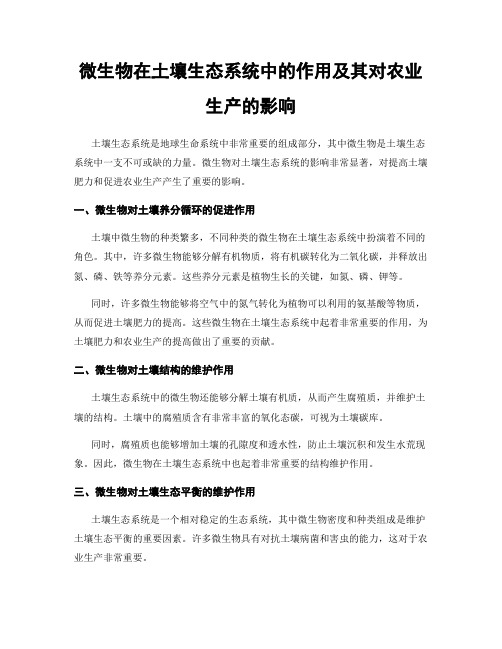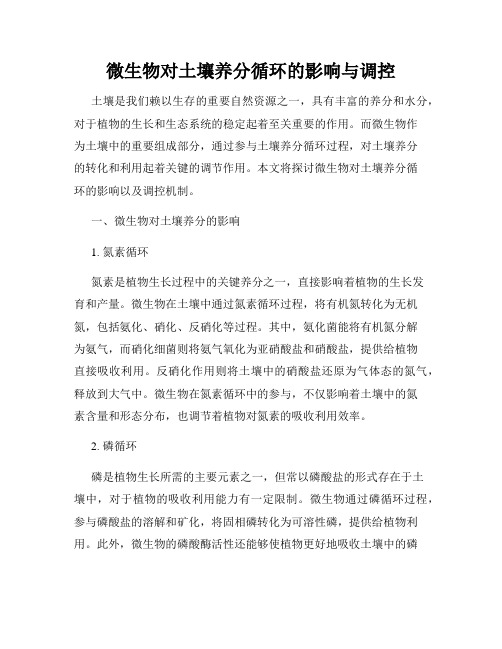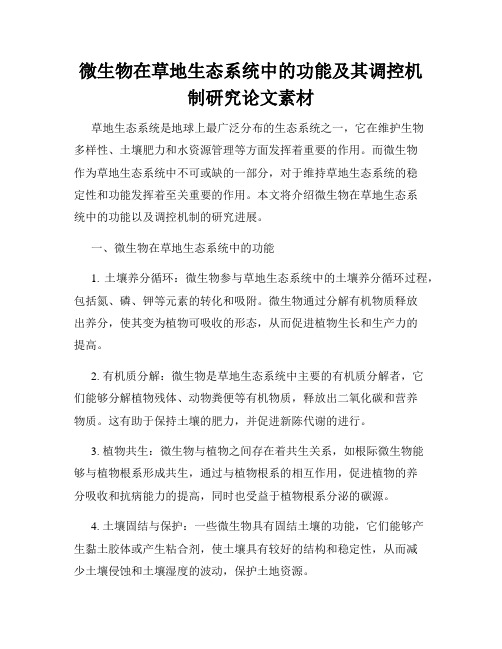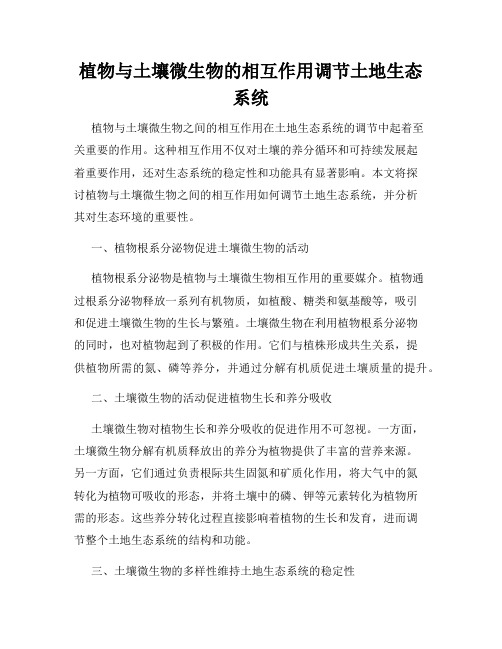植物与土壤微生物在调控生态系统养分循环中的作用
微生物对土壤养分循环的影响与调控

微生物对土壤养分循环的影响与调控土壤是地球上最为重要的生态系统之一,其包含着丰富的营养元素和巨量的微生物。
微生物对土壤养分循环起着至关重要的作用。
本文将探讨微生物对土壤养分循环的影响以及调控机制。
一、微生物对土壤养分循环的影响1. 构建养分循环网络:微生物通过不同的代谢途径参与土壤养分的转化与循环。
它们可以将有机物分解为无机营养物,如氨、亚硝酸盐和硝酸盐,从而提供给植物进行吸收利用。
同时,它们还能将土壤中的有机氮转化为固氮细菌可用的形式,进一步丰富土壤中的养分。
2. 促进养分的矿化和溶解:微生物通过分泌酶类降解有机物,将复杂的有机物分解为简单的养分,如磷和钾。
这些溶解的养分则可以被土壤中的植物迅速吸收,提供给它们的生长和发育。
3. 抑制养分的损失:微生物通过固定养分和形成稳定有机质的方式,减少养分的流失。
它们可以将无机氮转化为有机氮,存储在土壤中,防止氮的损失。
此外,微生物还能够稳定有机质,提高土壤质量,促进养分的循环和保持。
二、微生物对土壤养分循环的调控机制1. 生物固氮:微生物中的固氮菌能够将氮气还原为氨,供植物吸收。
这一过程称为固氮作用,通过与植物共生或自由生活的方式,微生物可以为土壤提供可利用的氮源。
2. 酶类催化:微生物通过分泌酶类催化反应,加速养分的矿化和溶解。
例如,磷酶可以降解有机磷,使其转化为可溶性的无机磷,供植物吸收。
3. 有机质的稳定性:微生物通过分解有机物、合成蛋白质和多糖物质,促进土壤有机质的积累和稳定。
这样一来,养分就能够长时间储存于土壤中,并且不易被流失。
4. 生物共生:微生物与植物、动物、真菌等形成共生关系,促进养分的有效转化和利用。
例如,根际微生物能够与植物根系共生,通过根系的分泌物和微生物的活动,提高土壤中养分的有效性。
5. 调控因子:微生物的活动受到土壤环境因子的影响,如温度、湿度、酸碱度等。
这些因素会影响微生物的代谢速率和群落结构,从而调控土壤养分循环的过程。
微生物对土壤养分循环与氮循环的影响

微生物对土壤养分循环与氮循环的影响土壤是生态系统中不可或缺的组成部分,其承载着丰富的微生物群落以及重要的养分循环过程。
微生物作为土壤中的重要参与者,对土壤养分循环以及氮循环发挥着重要的作用。
本文将探讨微生物对土壤养分循环与氮循环的影响,进一步加深我们对土壤生态功能的理解。
一、微生物在土壤养分循环中的作用1.有机质分解与养分释放土壤中的有机质主要由植物残体以及微生物的死亡体组成,而微生物在土壤中扮演着有机质降解的重要角色。
由于微生物能够分解有机物质,将其转化为无机养分,进而释放到土壤中,有效地提供植物所需的养分。
微生物通过腐殖质酶、蛋白酶等酶的分泌,将复杂的有机物分解为较简单的有机物,然后进一步分解为脂肪酸、糖类、氨基酸等,使其能够被植物吸收利用。
2.氮素转化氮循环是土壤中极为重要的一环,而微生物在其中发挥着重要作用。
在土壤中,微生物通过氮素转化过程,将有机氮转化为无机氮,从而促进了氮素的有效利用。
具体而言,微生物参与了氨化、硝化、反硝化等关键过程。
其中,氨化是指微生物将有机氮分解为氨,再进一步合成氨基酸等形式的无机氮。
硝化过程中,一部分微生物将氨氧化为亚硝酸,接着被其他微生物氧化为硝酸盐。
而反硝化则是将硝酸盐还原为氮气等形式,从而使氮素在环境中发生循环。
二、微生物对土壤氮循环的影响1.提高氮素利用效率微生物参与了氮素的转化过程,使得氮素能够以植物可利用的形式存在于土壤中。
通过分解有机氮、固定氮气等过程,微生物释放出了大量的氨和硝酸盐等形式的无机氮素,从而为植物提供了养分。
由于植物无法直接利用氮气,微生物在土壤中转化氮素形式,提高了氮素的利用效率,促进了植物的生长。
2.调节土壤氮素循环平衡微生物通过自身的代谢活动和调控作用,对土壤中氮素的循环平衡产生着重要影响。
例如,微生物在氨化过程中吸收氨气,从而抑制了氨的积累。
在硝化过程中,微生物的活动促进了硝酸盐的形成。
而在反硝化过程中,微生物通过还原反应将硝酸盐转化为氮气,从而调控了土壤中硝酸盐的含量。
微生物对土壤生态系统的影响与调控

微生物对土壤生态系统的影响与调控土壤是生物圈中最为复杂的生态系统之一,其中微生物起着至关重要的作用。
微生物对土壤生态系统起着促进或抑制的作用,同时也可以通过调控微生物群落结构和功能来改善土壤质量、促进植物生长等。
本文将探讨微生物对土壤生态系统的影响以及其调控机制。
一、微生物对土壤生态系统的影响微生物是土壤中最为丰富多样的生物群体,对土壤生态系统的影响主要体现在以下几个方面。
1. 养分循环和转化:微生物在土壤中参与了养分循环的各个环节。
例如,土壤中的一些细菌和真菌可以通过分解有机物质释放出养分,从而为植物的生长提供养分来源。
此外,一些微生物还能够将氮气转化为可被植物吸收的形式,促进氮的循环。
2. 有机质分解:微生物可以分解并降解有机质,将有机物质转化为无机物质,从而影响土壤的有机质含量和质量。
这种分解作用对土壤有机质的形成和矿化有着重要影响,进一步调节土壤养分的有效性。
3. 抗生素产生:一些土壤微生物能够产生抗生素,对其他微生物的生长起到抑制作用。
这种竞争关系直接影响了土壤微生物群落的结构和功能,并且对土壤生态系统的稳定性和健康性有一定的影响。
二、微生物对土壤生态系统的调控为了维持土壤生态系统的稳定性和健康性,对微生物的调控成为一项重要的任务。
以下是一些常用的微生物调控方法。
1. 施用有益微生物:选择一些对土壤生态系统有益的微生物,如解磷菌、氮结合菌等,并将其施加到土壤中,以增强土壤肥力和植物养分吸收能力。
这种方法可以通过调整土壤微生物群落结构,优化土壤生态系统功能。
2. 调控土壤环境条件:土壤微生物的生长和活动受到环境条件的影响。
调节土壤的pH值、温度、湿度等环境因素,可以控制优势菌群的生长和繁殖,从而调节土壤微生物群落结构和功能。
3. 合理利用土壤资源:合理施肥、减少化学农药使用、推广有机农业等方法可以减少对土壤生态系统的破坏,并为土壤中有益微生物提供适宜的生存环境。
这些措施不仅可以保护土壤微生物,还可以提高土壤质量和农产品的质量。
微生物在土壤生态系统中的作用及其对农业生产的影响

微生物在土壤生态系统中的作用及其对农业生产的影响土壤生态系统是地球生命系统中非常重要的组成部分,其中微生物是土壤生态系统中一支不可或缺的力量。
微生物对土壤生态系统的影响非常显著,对提高土壤肥力和促进农业生产产生了重要的影响。
一、微生物对土壤养分循环的促进作用土壤中微生物的种类繁多,不同种类的微生物在土壤生态系统中扮演着不同的角色。
其中,许多微生物能够分解有机物质,将有机碳转化为二氧化碳,并释放出氮、磷、铁等养分元素。
这些养分元素是植物生长的关键,如氮、磷、钾等。
同时,许多微生物能够将空气中的氮气转化为植物可以利用的氨基酸等物质,从而促进土壤肥力的提高。
这些微生物在土壤生态系统中起着非常重要的作用,为土壤肥力和农业生产的提高做出了重要的贡献。
二、微生物对土壤结构的维护作用土壤生态系统中的微生物还能够分解土壤有机质,从而产生腐殖质,并维护土壤的结构。
土壤中的腐殖质含有非常丰富的氧化态碳,可视为土壤碳库。
同时,腐殖质也能够增加土壤的孔隙度和透水性,防止土壤沉积和发生水荒现象。
因此,微生物在土壤生态系统中也起着非常重要的结构维护作用。
三、微生物对土壤生态平衡的维护作用土壤生态系统是一个相对稳定的生态系统,其中微生物密度和种类组成是维护土壤生态平衡的重要因素。
许多微生物具有对抗土壤病菌和害虫的能力,这对于农业生产非常重要。
同时,微生物对土壤有害物质的分解和降解也非常重要,如对重金属、农药等的分解能够减轻土壤污染和保护环境。
因此,微生物起着维护土壤生态平衡的重要作用。
四、微生物在农业生产中的重要作用微生物不仅在土壤生态系统中起着重要的作用,同时也在农业生产中有着重要的应用价值。
例如,在有机农业中,微生物肥料和微生物饵料可以增加土壤肥力和提高植物产量。
微生物酶制剂和保护剂可以促进植物生长、防止病害发生、提高抗性和产量等。
微生物在特定的农业生产领域中也有着广泛的应用,如水稻田农业、果树园艺、蔬菜生产等。
综上所述,微生物在土壤生态系统中起着重要的作用,对土壤肥力和农业生产产生了重要的影响。
植物的养分循环与土壤互作

植物的养分循环与土壤互作当我们走进大自然的花园,欣赏着各种各样鲜艳的花朵和郁郁葱葱的树木时,我们或许会想知道这些植物是如何获取养分并茁壮成长的。
事实上,植物依靠土壤中的养分循环与土壤进行互作,实现了生长发育的需要。
本文将深入探讨植物的养分循环与土壤互作的重要性以及相关机制。
一、植物养分循环的重要性植物对于养分的需求是生命活动所必需的,植物的营养需要源于土壤中的养分。
植物通过吸收土壤中的水分和气体,并从中获取所需的养分元素。
这些养分元素包括氮、磷、钾等主要的宏量元素,以及铁、锌、铜等微量元素。
植物获得充足的养分将促进其生长,增加产量,提高抗病虫害能力,从而对人类的生活和农业生产具有重要意义。
二、植物与土壤的互作植物与土壤之间的互作主要通过植物根系和土壤中的微生物共同完成。
植物根系利用其形状和分泌物质吸附和吸收土壤中的养分。
同时,植物根系在土壤中释放有机物质,如根黏菌素、根分泌的酸性物质等,这些有机物质可以改变土壤的酸碱度、离子平衡等环境条件,从而促进养分的释放和转化。
此外,土壤中的微生物也起着重要的作用,它们分解有机物质,释放出铁、锌等微量元素,进而为植物提供必要的养分。
三、植物养分循环的机制植物的养分循环包括吸收、转运和分配三个主要的环节。
首先,植物通过根系吸收土壤中的水分和溶解在水中的养分离子。
吸收的养分在根系内通过运输蛋白质进行转运,进入到植物体内。
这一过程主要受到根顶和侧根的调控。
最后,植物将吸收到的养分在体内分配到不同的组织器官中,以满足各个器官的生长发育的需要。
这种分配方式可以根据植物的生长状态和环境条件发生变化。
四、影响植物养分循环的因素植物养分循环受到多种因素的影响,包括土壤的理化性质、土壤水分状况、微生物活动等。
首先,土壤的pH值对于植物养分的吸收和释放有重要影响。
土壤的酸碱度与养分元素的形态和溶解度密切相关。
其次,土壤的通气性和保水性也对植物的养分吸收和利用起着重要作用。
合适的土壤水分状况可以维持植物根系的生理活性。
植物与土壤微生物的相互作用及生态功能

植物与土壤微生物的相互作用及生态功能植物和土壤微生物之间存在着密切的相互作用,这种相互作用对于维持生态系统平衡和保障土壤生产力具有重要意义。
本文将探讨植物与土壤微生物之间的相互作用及其对生态系统的功能。
一、植物与土壤微生物的相互作用植物与土壤微生物之间的相互作用是一种复杂的生物过程。
首先,植物通过根系与土壤微生物直接接触,形成根际微生物圈。
植物根系分泌的有机酸、激素和营养物质等可作为土壤微生物的营养来源,从而促进土壤微生物的繁殖和生长。
同时,植物根际的分泌物也能选择性地吸引一些有益微生物,例如根瘤菌和丛枝菌根真菌。
这些微生物与植物形成共生关系,能够为植物提供氮素、磷酸盐等养分,提高植物的养分吸收能力。
另外,植物还通过改变土壤环境条件来影响土壤微生物的种类和数量。
例如,植物的根系释放出的氧气可以改善土壤通气性,抑制厌氧微生物的生长。
此外,植物根系分泌的次生代谢产物和抗菌物质也可以对土壤微生物产生抑制作用,调控土壤微生物的群落结构。
二、植物与土壤微生物的生态功能植物与土壤微生物之间的相互作用对生态系统的功能发挥起到至关重要的作用。
1. 养分循环和养分利用:植物通过根系与土壤微生物的相互作用,能够促进土壤中养分的循环和利用。
一方面,植物根系分泌的有机酸和酶类可以降解土壤中的有机质,释放出固定的养分供植物吸收。
另一方面,土壤微生物通过分解植物残体和有机物,将有机质转化为可供植物吸收的无机化合物。
这种养分的循环和利用过程在维持土壤肥力方面起到关键作用。
2. 生物防治:植物通过与一些有益的土壤微生物形成共生关系,能够增强对病原菌和害虫的防御能力。
例如,植物和根瘤菌的共生关系可以通过固氮作用提供植物所需的氮素,同时也抑制了一些土壤中的植物病原真菌的生长。
此外,植物根系分泌的抗菌物质还可以直接抑制病原微生物的生长,起到生物防治的作用。
3. 土壤固碳:植物通过光合作用吸收二氧化碳,并将其转化为有机碳,然后通过根系与土壤微生物相互作用,将有机碳转化为土壤有机质。
微生物对土壤养分循环的影响与调控

微生物对土壤养分循环的影响与调控土壤是我们赖以生存的重要自然资源之一,具有丰富的养分和水分,对于植物的生长和生态系统的稳定起着至关重要的作用。
而微生物作为土壤中的重要组成部分,通过参与土壤养分循环过程,对土壤养分的转化和利用起着关键的调节作用。
本文将探讨微生物对土壤养分循环的影响以及调控机制。
一、微生物对土壤养分的影响1. 氮素循环氮素是植物生长过程中的关键养分之一,直接影响着植物的生长发育和产量。
微生物在土壤中通过氮素循环过程,将有机氮转化为无机氮,包括氨化、硝化、反硝化等过程。
其中,氨化菌能将有机氮分解为氨气,而硝化细菌则将氨气氧化为亚硝酸盐和硝酸盐,提供给植物直接吸收利用。
反硝化作用则将土壤中的硝酸盐还原为气体态的氮气,释放到大气中。
微生物在氮素循环中的参与,不仅影响着土壤中的氮素含量和形态分布,也调节着植物对氮素的吸收利用效率。
2. 磷循环磷是植物生长所需的主要元素之一,但常以磷酸盐的形式存在于土壤中,对于植物的吸收利用能力有一定限制。
微生物通过磷循环过程,参与磷酸盐的溶解和矿化,将固相磷转化为可溶性磷,提供给植物利用。
此外,微生物的磷酸酶活性还能够使植物更好地吸收土壤中的磷酸盐。
因此,微生物对于土壤中磷素的循环和植物的磷素吸收具有重要影响。
3. 钾循环钾是植物生长和发育所必需的微量元素,对于植物的抗病、抗寒和耐旱等生理过程起着重要作用。
微生物参与了钾元素在土壤中的转化和循环。
钾元素主要以矿物质的形式存在于土壤中,在微生物的代谢过程中,通过代谢产物的分解和酸性物质的释放,使土壤中的钾元素得以释放并可利用。
此外,微生物还能通过生物固氮的过程,将大气中的氮气转化为铵态氮,与土壤中的钾形成离子交换,促进植物对钾的吸收。
二、微生物对土壤养分循环的调控机制1. 分泌酶类物质微生物通过分泌多种酶类物质,对土壤中的有机物和矿物质进行降解和转化。
这些酶类物质包括蛋白酶、脂肪酶、纤维素酶等,能够将有机质进行分解,并释放出养分供植物吸收。
微生物在农田生态系统中的作用与生态效益分析

微生物在农田生态系统中的作用与生态效益分析农田生态系统是由土壤、植物、动物和微生物等多个生物体组成的复杂系统。
微生物作为农田生态系统中的重要组成部分,对于土壤质量的维持和农作物的生长发育具有重要的作用。
本文将从微生物对土壤养分循环、植物健康生长以及农田可持续发展等方面进行分析,探讨微生物在农田生态系统中的作用以及相关的生态效益。
一、微生物对土壤养分循环的作用微生物在土壤中扮演着分解有机物质、循环养分的重要角色。
首先,微生物通过分解有机物质释放出大量的酶,将有机物质转化为可供植物吸收的无机养分。
其次,微生物通过呼吸作用释放二氧化碳和其他气体,促进土壤通气,提高土壤微生物活动和生物可利用性养分的利用效率。
同时,微生物还能够合成和分泌一系列的生长物质,如植物生长激素和细胞生长因子,促进植物的生长发育。
综上所述,微生物通过分解有机物质、提供养分和促进植物生长等途径,对土壤养分循环发挥着重要的作用。
二、微生物对植物健康生长的作用微生物对植物的健康生长具有促进作用。
首先,土壤中的一些微生物能够与植物根系形成共生关系,如根瘤菌能够与豆科植物结合形成根瘤共生,通过固氮作用将大气中的氮转化为植物可吸收的氨基氮,提供植物所需的氮源。
其次,土壤中的其他微生物还能够与植物根系形成农田生态圈,通过释放抑制性物质抑制病原微生物生长,达到防治植物病虫害的效果。
此外,一些微生物还能够分泌有益物质,如抗生素和植物生长激素,促进植物的生长发育。
因此,微生物通过与植物形成共生关系、抑制植物病原微生物生长以及分泌有益物质等方式,对植物的健康生长起到积极的促进作用。
三、微生物对农田可持续发展的生态效益微生物在农田可持续发展中发挥着重要的生态效益。
首先,微生物通过提高土壤质量,促进植物生长发育,增加农作物产量。
例如,利用生物肥料和生物菌剂,可以增加土壤中有机质含量,改善土壤结构,提高土壤保水能力和保肥能力,从而提高农作物的产量和品质。
其次,微生物还能够降低农田化肥和农药的使用量,减少环境污染。
微生物在土壤生态系统中的功能

微生物在土壤生态系统中的功能土壤是生命的母体,是植物生长发育的重要基础。
微生物作为土壤生态系统中不可或缺的一部分,发挥着诸多重要的功能。
本文将从微生物的分解与转化、养分循环、植物生长调节等方面,探讨微生物在土壤生态系统中的功能。
一、微生物的分解与转化在土壤中,含有大量的有机物质,如植物残渣、动物排泄物等,这些有机物质需要被分解为更小的分子,才能被植物吸收利用。
而微生物是进行有机物质分解和转化的关键因素。
微生物通过代谢作用,将有机物质分解为简单的有机化合物和无机化合物,从而释放出植物所需的养分。
同时,微生物还能将有机物质转化为能量源,维持自身的生命活动。
二、养分循环微生物在土壤中的活动还可以促进养分的循环。
例如,在氮素循环中,氨化细菌通过将氮气转化为氨,为后续的硝化作用提供了必要的前提条件。
而硝化细菌则将氨氧化为亚硝酸盐和硝酸盐,这些无机化合物可以被植物利用。
此外,磷循环中的磷酸溶解菌也能够通过分泌脲酶、酸性磷酸酶等酶类,将有机磷酸转化为无机磷酸,使其能够被植物有效地吸收利用。
三、植物生长调节微生物在土壤中的活动还可以对植物的生长发育产生调节作用。
例如,一些细菌如拟杆菌、假单胞菌等可以通过产生生长素、激素酶等物质,调节植物生长发育和促进其根系生长。
同时,很多根际微生物还可以释放出有机酸、植物鞘质物、次生代谢物等物质,调节土壤环境,使其更适合植物生长。
此外,一些微生物还能够与植物形成共生关系,如根瘤菌、菌根菌等,与植物共生互惠,提高植物的养分吸收效率以及耐逆性。
总之,微生物在土壤生态系统中的功能是多种多样的,不仅是土壤有机物分解和转化的关键因素,也是土壤养分循环和植物生长调节的重要媒介。
因此,保护土壤生态系统,维持微生物的种群和活性,对于维持农业生产与生态平衡至关重要。
微生物在草地生态系统中的功能及其调控机制研究论文素材

微生物在草地生态系统中的功能及其调控机制研究论文素材草地生态系统是地球上最广泛分布的生态系统之一,它在维护生物多样性、土壤肥力和水资源管理等方面发挥着重要的作用。
而微生物作为草地生态系统中不可或缺的一部分,对于维持草地生态系统的稳定性和功能发挥着至关重要的作用。
本文将介绍微生物在草地生态系统中的功能以及调控机制的研究进展。
一、微生物在草地生态系统中的功能1. 土壤养分循环:微生物参与草地生态系统中的土壤养分循环过程,包括氮、磷、钾等元素的转化和吸附。
微生物通过分解有机物质释放出养分,使其变为植物可吸收的形态,从而促进植物生长和生产力的提高。
2. 有机质分解:微生物是草地生态系统中主要的有机质分解者,它们能够分解植物残体、动物粪便等有机物质,释放出二氧化碳和营养物质。
这有助于保持土壤的肥力,并促进新陈代谢的进行。
3. 植物共生:微生物与植物之间存在着共生关系,如根际微生物能够与植物根系形成共生,通过与植物根系的相互作用,促进植物的养分吸收和抗病能力的提高,同时也受益于植物根系分泌的碳源。
4. 土壤固结与保护:一些微生物具有固结土壤的功能,它们能够产生黏土胶体或产生粘合剂,使土壤具有较好的结构和稳定性,从而减少土壤侵蚀和土壤湿度的波动,保护土地资源。
二、微生物在草地生态系统中的调控机制1. 土壤酶活性:土壤酶活性是评估微生物代谢活动和土壤质量的重要指标。
研究表明,土壤中的微生物活性与酶活性密切相关,土壤中丰富多样的微生物群落能够促进酶的活化,从而加速物质的转化和循环。
2. 生物多样性:微生物的种类和多样性对草地生态系统的功能发挥至关重要。
生物多样性的增加能够提高草地生态系统的稳定性和抗干扰能力,减少病虫害的发生,并促进植物养分吸收和生长。
3. 氮循环与固氮作用:微生物参与草地生态系统中的氮循环过程,包括氮的硝化、反硝化和固氮等。
固氮微生物能够将大气中的氮转化为植物可吸收的形式,提供重要的养分来源。
4. 植物与微生物互作:植物根际微生物对植物生长和营养吸收有重要影响。
微生物对土壤养分循环和植物营养吸收的影响研究

微生物对土壤养分循环和植物营养吸收的影响研究引言:土壤是植物生长的重要基质,其中养分的循环和植物的营养吸收是维持生态系统平衡的关键过程。
微生物在土壤中扮演着重要角色,它们通过分解有机物质、固氮、解磷等作用,参与到养分循环和植物营养吸收中。
本文将重点探讨微生物对土壤养分循环和植物营养吸收的影响及其研究进展。
一、微生物参与土壤养分的释放和循环土壤中有机质的分解是养分释放和循环的关键步骤之一,而微生物在其中发挥着重要作用。
微生物通过分解有机物质,将复杂的有机物分解为简单的无机化合物,如氨、硝酸根等,供植物吸收利用。
此外,微生物还能分解有机磷化合物,使其转化为无机磷形式,如磷酸盐,增加植物的磷营养可利用性。
研究表明,微生物通过多样的酶系统参与有机物质的降解,同时也受到土壤环境因素的影响,如温度、湿度、pH值等。
二、微生物与植物根系的相互作用微生物通过与植物根系形成共生关系,对植物的营养吸收起到了重要的影响。
植物根系分泌的有机物质如小分子有机酸、氨基酸等,为微生物提供了能量和营养物质,同时吸附在根际土壤颗粒上形成根际土壤环境。
根际微生物通过分泌酶类,促进养分的释放和转化,增加植物的养分利用能力。
另一方面,微生物还能通过抑制土壤病原菌的生长,增强植物的抗病能力。
三、微生物对植物营养元素的转化和固定微生物不仅能够促进养分的循环和吸收,还参与植物营养元素的转化和固定。
例如,一些细菌和蓝藻具有固氮能力,它们能将大气中的氮转化为植物可利用的氨态氮或硝酸盐。
此外,微生物还参与铁、锰等微量元素的转化和解吸。
其中,铁还与土壤中的磷酸根形成络合物,降低磷的活性,从而减缓磷的流失速率。
四、微生物对植物养分吸收的调控机制微生物对植物养分吸收的调控机制主要包括直接和间接两个方面。
直接机制是通过根际土壤环境的调节和养分的转化来影响植物养分吸收。
例如,微生物分解有机物质产生的无机氮、磷可以直接被植物吸收利用。
间接机制是通过调节植物根系和微生物相互作用的信号物质来影响植物养分吸收。
微生物对土壤生态系统结构与功能的影响与调控

微生物对土壤生态系统结构与功能的影响与调控微生物是土壤生态系统中极为重要的组成成分,在维持土壤健康和功能方面发挥着至关重要的作用。
本文将深入探讨微生物对土壤生态系统结构与功能的影响,并阐述调控微生物对土壤生态系统的重要性。
1. 微生物在土壤结构形成中的作用微生物在土壤结构形成中起着关键性的作用。
首先,微生物通过生理代谢过程分解有机物质,产生黏土胶体,促进土壤颗粒结合。
其次,微生物通过胞外多糖及胞内物质的产生和分泌,对土壤颗粒进行胶结,形成土壤团聚体。
最后,微生物还能产生胞外酶,使土壤颗粒表面发生化学反应,有利于土壤结构稳定。
2. 微生物对土壤养分循环的影响微生物在土壤养分循环中具有重要作用。
微生物能通过分解有机物质、氮的固氮以及磷、硫和铁等元素的溶解、酸化和氧化还原等过程,将有机质中的养分释放到土壤中,提供植物所需的养分。
此外,微生物还能通过与根系的共生作用,提高植物对养分的利用效率。
3. 微生物对土壤生物多样性的维持微生物对土壤生物多样性的维持至关重要。
微生物通过调节土壤中的养分利用和竞争关系,遏制有害微生物的生长,促进土壤中有益微生物的繁殖和活动,从而维持土壤中的生物多样性。
此外,微生物还能与其他生物之间进行共生关系,促进土壤中其他生物群落的繁荣。
4. 调控微生物对土壤生态系统的重要性调控微生物对土壤生态系统的健康和功能至关重要。
首先,对土壤微生物进行适当的调控可以提高土壤的养分循环效率,增强土壤的肥力。
其次,调控微生物可以降低土壤中害虫和病原菌的数量,减少植物疾病的发生。
此外,通过调控微生物的组成和功能,可以提高土壤碳储存能力,减缓气候变化。
综上所述,微生物对土壤生态系统的结构与功能具有重要影响,并可以通过适当调控来改善土壤的健康状况和功能。
因此,进一步研究微生物与土壤生态系统的关系,并探索有效的调控方法,对于保护和恢复土壤生态系统的稳定和健康具有重要意义。
植物与土壤微生物的相互作用调节土地生态系统

植物与土壤微生物的相互作用调节土地生态系统植物与土壤微生物之间的相互作用在土地生态系统的调节中起着至关重要的作用。
这种相互作用不仅对土壤的养分循环和可持续发展起着重要作用,还对生态系统的稳定性和功能具有显著影响。
本文将探讨植物与土壤微生物之间的相互作用如何调节土地生态系统,并分析其对生态环境的重要性。
一、植物根系分泌物促进土壤微生物的活动植物根系分泌物是植物与土壤微生物相互作用的重要媒介。
植物通过根系分泌物释放一系列有机物质,如植酸、糖类和氨基酸等,吸引和促进土壤微生物的生长与繁殖。
土壤微生物在利用植物根系分泌物的同时,也对植物起到了积极的作用。
它们与植株形成共生关系,提供植物所需的氮、磷等养分,并通过分解有机质促进土壤质量的提升。
二、土壤微生物的活动促进植物生长和养分吸收土壤微生物对植物生长和养分吸收的促进作用不可忽视。
一方面,土壤微生物分解有机质释放出的养分为植物提供了丰富的营养来源。
另一方面,它们通过负责根际共生固氮和矿质化作用,将大气中的氮转化为植物可吸收的形态,并将土壤中的磷、钾等元素转化为植物所需的形态。
这些养分转化过程直接影响着植物的生长和发育,进而调节整个土地生态系统的结构和功能。
三、土壤微生物的多样性维持土地生态系统的稳定性土壤微生物的多样性对土地生态系统的稳定性至关重要。
不同种类的土壤微生物在植物根际形成了复杂的相互关系网络,这种相互关系使得土壤微生物之间能够相互合作、互利共生。
如果土壤微生物多样性受到破坏,例如由于过度施用农药或破坏了自然生境,将引发土壤微生物的种群失衡,导致土地生态系统的不稳定。
因此,保护土壤微生物的多样性和生物量,维护土地生态系统的平衡,对于生态环境的可持续发展至关重要。
四、植物与土壤微生物共同应对环境压力植物和土壤微生物具有一定的适应性,能够通过相互作用来共同应对环境压力。
当土地受到污染或大面积退化时,一些植物和土壤微生物能够通过与彼此合作,抑制有害物质的积累,修复环境,恢复土地生态系统的平衡。
农业生态系统中养分循环的特征

农业生态系统中养分循环的特征一、概述农业生态系统是指农田、水田、养殖场等农业生产的场所,其中包括了植物、动物、微生物以及它们的生态关系。
在农业生态系统中,养分循环是一个非常重要的过程,它直接影响着农田的肥力和生产力。
深入了解农业生态系统中养分循环的特征,对于优化农业生产、保护环境具有重要意义。
二、养分循环的基本概念1. 养分循环指的是在农业生态系统中,元素和化合物通过植物、土壤、微生物等之间的物质代谢和能量流动,发生转化和再循环的过程。
主要包括了氮循环、磷循环、钾循环等。
2. 养分循环是一个动态平衡的过程,其中有物质的输入、输出以及在系统内外的转化和传递过程。
三、养分循环的特征1. 多元循环农业生态系统中的养分循环是一个多元循环的过程,不同养分(如氮、磷、钾等)之间相互影响,相互转化。
氮在土壤中可以发生矿物化、硝化、还原等多种形式的循环,同时与磷、钾等养分之间也会有一定的相互作用。
2. 生物化学循环养分循环是一个生物与化学过程相结合的循环过程。
在农田中,植物通过光合作用吸收二氧化碳,合成有机物,通过植物根系释放出根际溶液,进而影响土壤中养分的形态和转化。
而土壤中的微生物又通过分解有机物,将养分转化为植物可利用的形态。
3. 养分稳定性养分循环中,养分的稳定性是一个重要特征。
有些养分在土壤中会发生固定,变得不易被植物吸收,而有些养分则会发生淋溶、挥发等现象,导致养分的流失。
了解养分在土壤中的稳定性,对于养分的合理利用和保护至关重要。
四、影响养分循环的因素1. 土壤性质不同种类的土壤,其养分循环特征也会有所差异。
酸性土壤中的铝、锰等元素循环会受到影响,而碱性土壤中的磷循环又会有不同的特点。
2. 植物作用不同类型的植物对养分循环也会产生重要影响。
一些植物具有很强的养分吸收能力,可以提高土壤中的养分含量;而有些植物则会在土壤中释放出有机物,促进土壤微生物的活动,从而影响养分的转化和循环。
3. 微生物作用土壤中的微生物是养分循环的重要参与者,它们通过分解有机质、硝化、还原等过程,促进养分的循环。
植物与土壤微生物的相互作用与生态效应

植物与土壤微生物的相互作用与生态效应植物和土壤微生物之间的相互作用是生态系统中一个重要而复杂的过程。
这种相互作用对土壤生物多样性、养分循环和生态系统的稳定性都起着至关重要的作用。
本文将详细探讨植物与土壤微生物的相互作用机制以及这种相互作用对生态系统的影响。
一、植物与土壤微生物的相互作用机制植物与土壤微生物之间的相互作用是一种复杂的生物过程,涉及到多种因素和机制。
以下是几种常见的相互作用机制:1. 根际交流:植物根系分泌的营养物质和有机物质为土壤微生物提供了良好的生存条件。
同时,这些分泌物也能吸引一些对植物有益的土壤微生物,如一些氮固定细菌和磷溶解细菌。
2. 共生关系:植物与土壤微生物之间可以形成共生关系,互相促进生长和发展。
例如,一些根瘤菌与豆科植物形成共生关系,通过提供固定氮素来为植物提供养分;而植物根系分泌的一些有机物则为这些根瘤菌提供能量。
3. 抗病免疫:土壤微生物对植物的免疫系统起着重要作用。
一些土壤微生物可以调节植物的免疫反应,抵御病原微生物的入侵。
同时,植物的免疫反应也能促进土壤微生物的生长和多样性。
4. 养分循环:植物通过根系分泌的有机物质和根系的降解物质为土壤微生物提供碳源和能量。
土壤微生物则通过分解有机物质和寄生物质,将养分释放给植物吸收和利用。
二、植物与土壤微生物的生态效应植物与土壤微生物的相互作用对生态系统具有重要的影响,主要体现在以下几个方面:1. 土壤质地形成:植物的根系和土壤微生物的活动能够改善土壤结构和质地,增加土壤的含水量和通气性。
这对于提高土壤的肥力和保持水分具有重要意义。
2. 养分循环和转化:土壤微生物是土壤养分的重要转化者和释放者。
它们通过分解有机物质和循环养分,促进了养分的有效利用和再循环。
这对于维持生态系统的养分平衡和稳定性至关重要。
3. 植物生长和抗病能力:土壤微生物对植物的生长和健康状态具有显著影响。
一些有益微生物能够促进植物的生长和发育,提高植物的抗逆性和抗病能力。
草地生态系统中土壤微生物对植物养分利用效率的影响机制研究

草地生态系统中土壤微生物对植物养分利用效率的影响机制研究草地生态系统是自然界中重要的生物群落之一,具有重要的生态功能和经济价值。
然而,草地的生长和发展离不开土壤中的养分供应,尤其是微生物的作用对于植物养分利用效率有着重要的影响。
本文将探讨草地生态系统中土壤微生物对植物养分利用效率的影响机制。
一、土壤微生物对养分供应的作用土壤微生物是草地生态系统中重要的组成部分,它们通过分解有机质、固定氮气、矿化无机养分等活动,为植物提供了养分供应。
土壤微生物通过分解有机质,将有机物分解为无机养分,使其更易被植物吸收利用。
此外,土壤微生物还能够分解难以降解的有机物,提高养分的有效性。
因此,土壤微生物对养分供应具有重要的促进作用。
二、土壤微生物对植物根系的辅助功能土壤微生物与植物根系之间存在着共生关系,微生物通过与植物根系的互作用促进植物根系的发育和生长,提高植物对养分的吸收能力。
例如,土壤中的一些微生物能够产生激素和生长因子,促进植物的生长;一些微生物能够分解有机物,为植物提供养分。
同时,土壤微生物还能够与植物根系形成共生关系,在根系表面形成菌根结构,增加植物根系与土壤的接触面积,进一步提高养分的吸收效率。
三、土壤微生物对养分循环的影响草地生态系统中的土壤微生物能够影响养分的循环过程,进而影响植物的养分利用效率。
土壤中的微生物通过分解有机质和固定氮气等活动,促进养分的转化和释放,使其更易被植物吸收利用。
此外,土壤微生物还能够分解有机物和重要元素,将其转化为植物可直接吸收的形式,进一步提高养分的利用效率。
四、土壤微生物与植物共生的调节因素草地生态系统中土壤微生物与植物共生的调节因素主要包括土壤环境因子和植物因子。
土壤的温度、湿度、酸碱度等因子对土壤微生物的生长和活动有着重要的影响;而植物的根系形态、分泌物等因子则影响了土壤微生物与植物根系之间的互作用。
此外,土壤微生物的多样性和功能群的组成也会影响微生物对植物养分利用效率的影响。
微生物对土壤肥力和养分循环的影响

微生物对土壤肥力和养分循环的影响一、引言土壤作为生物生长和发展的基础,其肥力和养分循环对于提高农作物产量和维持生态系统平衡至关重要。
然而,与土壤物理性质和化学性质相比,微生物在土壤中的作用往往被人们忽视。
事实上,微生物通过参与土壤有机质分解、提供植物所需养分以及协助养分循环等多种途径,对土壤肥力和养分循环起着不可或缺的关键作用。
本文将探讨微生物对土壤肥力和养分循环的影响。
二、微生物的角色1. 有机质分解微生物在土壤中分解有机质是维持土壤肥力的重要途径。
通过分泌酶类,微生物能够将有机质中的复杂有机物分解为小分子有机化合物,进而被植物吸收和利用。
此过程不仅释放了有机氮、有机磷和有机钾等植物养分,还生成了稳定的有机质,提升土壤肥力。
2. 氮循环微生物在氮循环中起着至关重要的作用。
在土壤中,微生物可以将有机氮转化为无机氮,促进氮的释放和转化。
此外,微生物还能够固定大气中的氮,将其转化为植物可利用的氨、硝酸盐等形式,为植物提供养分。
3. 磷循环微生物通过磷酸酶酶活性,能够将有机磷分解为无机磷,并使其变得可溶性,从而提高土壤中磷的有效性。
此外,微生物还能够与根系共生形成菌根,促进磷的吸收。
4. 碳循环微生物通过分解植物残体和有机质,释放出二氧化碳,并参与土壤中的碳循环过程。
微生物代谢所产生的二氧化碳可被植物吸收,供其光合作用,同时也影响土壤中的pH值。
三、微生物与土壤肥力的关系1. 提高土壤肥力微生物参与有机质分解,释放出植物所需的养分,如有机氮、无机磷和无机钾等,从而提高土壤肥力和植物生长。
2. 保持养分平衡微生物在土壤中协助养分的循环与平衡,避免养分的流失和过度富集。
微生物通过吸附、钝化等方式,调控土壤中养分的有效性和可利用性,使得养分循环得以平衡。
3. 改善土壤结构微生物通过胞体分解释放粘土胶体、胶体聚集物等有机物质,促进土壤颗粒结合,改善土壤结构和通透性,提高空气和水分的渗透性,从而改善土壤的肥力。
植物的养分循环与土壤微生物

植物的养分循环与土壤微生物植物是地球生态系统中至关重要的组成部分,它们通过光合作用从环境中获取能量并转化为有机物质。
为了完成这一过程,植物需要从土壤中获取必要的营养元素。
而土壤微生物在植物营养循环中扮演着重要的角色。
本文将讨论植物的养分循环与土壤微生物之间的相互作用以及对生态系统的影响。
1. 植物对养分的需求植物对养分的需求包括氮、磷、钾等主要营养元素,以及微量元素如铁、锌等。
这些养分在土壤中以无机形式存在,植物通过根系吸收并转化为有机形式利用。
例如,氮是植物合成蛋白质和核酸的关键元素,磷是ATP和DNA分子的组成元素,钾则参与植物的水分平衡和光合作用。
2. 土壤微生物的功能土壤微生物包括细菌、真菌和原生动物等多种微生物生物体,它们在土壤中起到解析、矿化、转化和固定养分的作用。
细菌通过分解有机物质释放出养分,真菌则以分解纤维素和腐植质为生,并将养分转化为可被植物吸收的形式。
有些土壤中的微生物还可以与植物根系形成共生关系,如固氮菌能够将空气中的氮转化为植物可利用的形式。
3. 微生物参与养分循环的机制微生物参与养分循环的机制可以通过生物固氮、矿化、硝化和铵化等过程来解释。
一些微生物具有固氮能力,它们将空气中的氮转化为植物可吸收的形式。
矿化是指微生物分解有机物质并释放出养分的过程,在这一过程中,有机氮转化为无机氮。
硝化是指将氨转化为硝酸盐的过程,这一过程由硝化细菌完成。
铵化是指将硝酸盐还原为氨的过程,这一过程由铵化细菌参与。
4. 微生物与植物根系的相互作用植物的根系分泌出根际物质,这些物质对土壤微生物的生长和活动起到重要影响。
一方面,根际物质提供了微生物所需的碳源和能量,促进了微生物的生长;另一方面,微生物也通过分解根际物质释放出养分,供植物吸收利用。
此外,一些微生物还能与植物根系形成共生关系,如根瘤菌和豆科植物的共生关系能够固氮,为植物提供丰富的氮源。
5. 土壤微生物对生态系统的影响土壤微生物对生态系统的影响表现在多个方面。
微生物对土壤养分循环过程调控科学认知

微生物对土壤养分循环过程调控科学认知土壤是地球上重要的自然资源之一,承载着生物多样性及农作物的生长发育。
而微生物是土壤中不可或缺的一环,对土壤养分循环过程的调控具有至关重要的作用。
本文将深入探讨微生物对土壤养分循环过程的科学认知。
一、土壤养分循环过程的概述土壤养分循环过程包括养分的吸收、转化、释放和迁移等阶段。
这个循环过程可以通过微生物的活动得到调控,微生物参与其中的反应过程高度复杂且密切相关。
在土壤环境中,微生物主要通过异化作用和同化作用来调控养分的转化和循环。
二、微生物的异化作用1. 氮素循环氮素是植物生长所需的重要养分之一,而土壤中存在的主要有机氮形式是有机物和氨态氮。
微生物通过分解有机物和氨态氮,将其转化为可供植物吸收的无机氮形式。
此外,一些特定微生物还能进行硝化作用和反硝化作用,将氨态氮和硝酸盐转化为互相可转化的形式,从而参与土壤中氮素的循环。
2. 磷循环磷是植物所需的另一个重要养分,而土壤中的磷主要以无机磷和有机磷的形式存在。
微生物通过分泌酸性代谢产物和酶的作用,降低土壤中无机磷的溶解度,并促进其被植物吸收利用。
同时,微生物还能通过纤维素和蛋白质的分解释放出有机磷,将其转化为可供植物吸收的形式。
3. 钾循环钾是植物生长所必需的宏量元素之一,而土壤中的钾主要以矿物形式和钙钠交换形式存在。
微生物通过分解有机物和矿物颗粒,释放出可供植物吸收的钾离子。
此外,微生物的生长代谢也会导致大量的钾离子的释放,促进土壤中钾元素的再分配和循环利用。
三、微生物的同化作用除了通过异化作用调控土壤养分的转化和循环外,微生物还通过同化作用参与土壤养分的累积和固定过程。
1. 有机质的固定与储存微生物通过利用有机物质进行养分循环,并通过同化作用将有机质的碳固定在土壤中。
这种有机质的固定不仅为土壤提供了长久的养分供应,还能增加土壤的保水能力和抗逆性。
2. 植物营养元素的转化和固定微生物通过共生作用和化学反应参与植物营养元素的转化和固定。
- 1、下载文档前请自行甄别文档内容的完整性,平台不提供额外的编辑、内容补充、找答案等附加服务。
- 2、"仅部分预览"的文档,不可在线预览部分如存在完整性等问题,可反馈申请退款(可完整预览的文档不适用该条件!)。
- 3、如文档侵犯您的权益,请联系客服反馈,我们会尽快为您处理(人工客服工作时间:9:00-18:30)。
植物生态学报 2010, 34 (8): 979–988 doi: 10.3773/j.issn.1005-264x.2010.08.011 Chinese Journal of Plant Ecology 植物与土壤微生物在调控生态系统养分循环中的作用蒋婧宋明华*中国科学院地理科学与资源研究所中国生态系统研究网络综合研究中心, 生态系统网络观测与模拟重点实验室, 北京 100101摘要陆地生态系统的地上、地下是相互联系的。
植物与土壤微生物作为陆地生态系统中的重要组成部分, 它们之间的相互作用是生态系统地上、地下结合的重要纽带。
该文首先介绍了植物在养分循环中对营养元素的吸收、积累和归还等作用, 阐述了土壤微生物对养分有效性及土壤质量具有重要的作用。
其次, 重点综述了植物与土壤微生物之间相互依存、相互竞争的关系。
植物通过其凋落物与分泌物为土壤微生物提供营养, 土壤微生物作为分解者提供植物可吸收的营养元素, 比如共生体菌根真菌即可使植物根与土壤真菌达到互惠。
然而, 植物的养分吸收与微生物的养分固持同时存在, 因而两者之间存在对养分的竞争。
通过植物多样性对土壤微生物多样性的影响分析, 以及土壤微生物直接或间接作用于植物多样性和生产力的分析, 探讨了植物物种多样性与土壤微生物多样性之间的内在联系。
针对当前植物与土壤微生物对养分循环的调控机制的争论, 提出植物凋落物是调节植物与土壤微生物养分循环的良好媒介, 植物与土壤微生物的共同作用对维持整个生态系统的稳定性具有重要意义。
也指出了目前在陆地生态系统地上、地下研究中存在的不足和亟待解决的问题。
关键词地上地下, 养分循环, 植物, 土壤微生物Review of the roles of plants and soil microorganisms in regulating ecosystem nutrient cycling JIANG Jing and SONG Ming-Hua*Key Laboratory of Ecosystem Network Observation and Modeling, Chinese Ecosystem Research Network Synthesis Research Center, Institute of Geographic Sciences and Natural Resources Research, Chinese Academy of Sciences, Beijing 100101, ChinaAbstractAbove- and below-ground are important components of terrestrial ecosystems. Plants and microorganisms are dependent on each other, and they are important in the linkage between above- and below-ground processes. The relationship between plants and soil microorganisms and the fundamental role played by above- and be-low-ground feedbacks are important in controlling ecosystem processes and properties. Plant species play a fun-damental role in nutrient absorption, nutrient accumulation, nutrient distribution and nutrient return. Soil micro-organisms are important in controlling plant nutrient availability and soil quality. Our main objective is to summa-rize the relationships between plants and microbes, such as facilitation and competition. Plants, as producers, pro-vide nutrients for soil microorganisms via leaf litter and root exudation. Soil microorganisms, as decomposers, break down organic matter and provide nutrients to plants. A wide range of soil microbes form intimate symbiotic associations with plants, and this can stimulate plant productivity by delivering limited nutrients to their host plants. However, both plants and microbes compete for nutrients because plant nutrient uptake and microbial im-mobilization occur simultaneously. We provide an integrated analysis of effects of plant diversity on soil microbial diversity, as well as direct and indirect effects of soil microbes on plant diversity and productivity. Previously, the mechanisms of plants and microorganisms in regulating ecosystem nutrient cycling have been controversial. Litter chemical composition and diversity should be considered important functional traits that explain the mechanisms. It is clear that interactions between plants and microbes play a fundamental role in maintaining the stability of natural ecosystems. This review elucidates the linkage between aboveground and belowground processes, which have been treated separately in the past.Key words above- and below-ground, nutrient cycling, plant, soil microorganisms——————————————————收稿日期 Received: 2009-12-29 接受日期 Accepted: 2010-04-13* 通讯作者Author for correspondence (E-mail: songmh@)980 植物生态学报Chinese Journal of Plant Ecology 2010, 34 (8): 979–988陆地生态系统的地上、地下是相互联系的, 传统研究往往过多地关注地上生物群落, 而忽略了地下生物群落在陆地生态系统中的重要作用(Bardgett et al., 2005), 地下生物群落及其生态过程一直被认为是“黑匣子”(black box), 因而地下生物群落成为生态系统功能研究中最不确定的部分(Reynolds et al., 2003)。
近20年来分子生物学方法和技术应用于土壤微生物群落调查与功能评价方面取得了很大进展(Torsvik, 1980; Torsvik et al., 1990; Muyzer et al., 1993; Schwieger & Tebbe, 1998; Ogram, 2000), 越来越多的研究关注于地上、地下生态过程之间的作用与反馈(Porazinska et al., 2003; Bardgett et al., 2005), 这使得通过地上和地下生态过程的结合从整体上探讨它们在调控生态系统结构和功能中的作用成为可能。
植物与土壤微生物之间的作用与反馈是生态系统地上、地下结合的重要纽带, 因此, 揭示二者在养分循环中的调控机制可以使我们深入理解生态系统稳定性维持的内在机制。
1 植物在生态系统养分循环过程中的作用养分元素的循环利用是陆地生态系统的主要功能过程之一, 养分循环与平衡直接影响着生态系统生产力的高低, 并关系到生态系统的稳定性。
其中, 碳、氮作为陆地生态系统最关键的两大生源要素, 在植物体内的分配和代谢决定着植物的生长过程及其生产力(许振柱和周广胜, 2007), 在自然界的循环过程中对全球变化做出了重要贡献(彭琴等, 2008)。
森林和其他陆地植被可用来吸收部分温室气体, 缓解气候变化, 在碳、氮养分循环中发挥着重要作用, 这些作用主要体现在植物对碳、氮等营养元素的吸收、积累以及养分归还等方面。
中国有将近14%的森林覆盖率, 1982–2000年中国森林生物量碳的贮存量显著增加(Piao et al., 2009), 草地生态系统碳素总储量更占到陆地生态碳素总储量的15.2% (董云社和齐玉春, 2006)。
Högberg 和Read (2006)研究表明, 释放到大气中的碳有一半来自于植物根系、菌根真菌, 以及其他与根相关的微生物。
植物进行光合作用吸收CO 2、贮存碳素的同时, 从土壤中吸收适量的可利用N 构成生物有机体, 在有机体和土壤间维持一定的比例关系, 即C/N 比。
C/N 比在很大程度上控制着植物碳生产以及植物向土壤归还有机物质等C 、N 循环的关键过程, 并影响着植物体内养分的积累与分配(Luo et al., 2004)。
